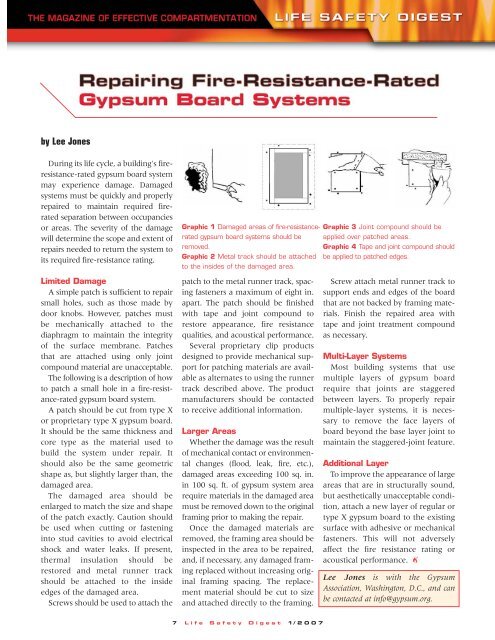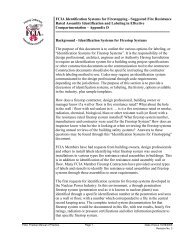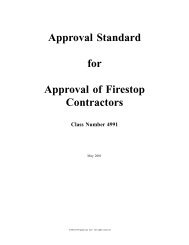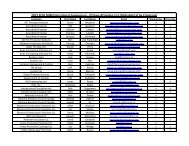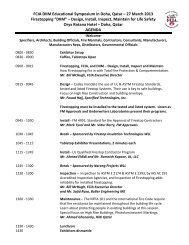Winter 2007 - FCIA - Firestop Contractors International Association
Winter 2007 - FCIA - Firestop Contractors International Association
Winter 2007 - FCIA - Firestop Contractors International Association
You also want an ePaper? Increase the reach of your titles
YUMPU automatically turns print PDFs into web optimized ePapers that Google loves.
y Lee Jones<br />
During its life cycle, a building's fireresistance-rated<br />
gypsum board system<br />
may experience damage. Damaged<br />
systems must be quickly and properly<br />
repaired to maintain required firerated<br />
separation between occupancies<br />
or areas. The severity of the damage<br />
will determine the scope and extent of<br />
repairs needed to return the system to<br />
its required fire-resistance rating.<br />
Graphic 1 Damaged areas of fire-resistancerated<br />
gypsum board systems should be applied over patched areas.<br />
Graphic 3 Joint compound should be<br />
removed.<br />
Graphic 4 Tape and joint compound should<br />
Graphic 2 Metal track should be attached be applied to patched edges.<br />
to the insides of the damaged area.<br />
Limited Damage<br />
A simple patch is sufficient to repair<br />
small holes, such as those made by<br />
door knobs. However, patches must<br />
be mechanically attached to the<br />
diaphragm to maintain the integrity<br />
of the surface membrane. Patches<br />
that are attached using only joint<br />
compound material are unacceptable.<br />
The following is a description of how<br />
to patch a small hole in a fire-resistance-rated<br />
gypsum board system.<br />
A patch should be cut from type X<br />
or proprietary type X gypsum board.<br />
It should be the same thickness and<br />
core type as the material used to<br />
build the system under repair. It<br />
should also be the same geometric<br />
shape as, but slightly larger than, the<br />
damaged area.<br />
The damaged area should be<br />
enlarged to match the size and shape<br />
of the patch exactly. Caution should<br />
be used when cutting or fastening<br />
into stud cavities to avoid electrical<br />
shock and water leaks. If present,<br />
thermal insulation should be<br />
restored and metal runner track<br />
should be attached to the inside<br />
edges of the damaged area.<br />
Screws should be used to attach the<br />
patch to the metal runner track, spacing<br />
fasteners a maximum of eight in.<br />
apart. The patch should be finished<br />
with tape and joint compound to<br />
restore appearance, fire resistance<br />
qualities, and acoustical performance.<br />
Several proprietary clip products<br />
designed to provide mechanical support<br />
for patching materials are available<br />
as alternates to using the runner<br />
track described above. The product<br />
manufacturers should be contacted<br />
to receive additional information.<br />
Larger Areas<br />
Whether the damage was the result<br />
of mechanical contact or environmental<br />
changes (flood, leak, fire, etc.),<br />
damaged areas exceeding 100 sq. in.<br />
in 100 sq. ft. of gypsum system area<br />
require materials in the damaged area<br />
must be removed down to the original<br />
framing prior to making the repair.<br />
Once the damaged materials are<br />
removed, the framing area should be<br />
inspected in the area to be repaired,<br />
and, if necessary, any damaged framing<br />
replaced without increasing original<br />
framing spacing. The replacement<br />
material should be cut to size<br />
and attached directly to the framing.<br />
Screw attach metal runner track to<br />
support ends and edges of the board<br />
that are not backed by framing materials.<br />
Finish the repaired area with<br />
tape and joint treatment compound<br />
as necessary.<br />
Multi-Layer Systems<br />
Most building systems that use<br />
multiple layers of gypsum board<br />
require that joints are staggered<br />
between layers. To properly repair<br />
multiple-layer systems, it is necessary<br />
to remove the face layers of<br />
board beyond the base layer joint to<br />
maintain the staggered-joint feature.<br />
Additional Layer<br />
To improve the appearance of large<br />
areas that are in structurally sound,<br />
but aesthetically unacceptable condition,<br />
attach a new layer of regular or<br />
type X gypsum board to the existing<br />
surface with adhesive or mechanical<br />
fasteners. This will not adversely<br />
affect the fire resistance rating or<br />
acoustical performance.<br />
Lee Jones is with the Gypsum<br />
<strong>Association</strong>, Washington, D.C., and can<br />
be contacted at info@gypsum.org.<br />
7 Life Safety Digest 1/<strong>2007</strong>


